Is Lakshmi a temporary post like Brahma, Rudra, Indra? | Do Lakshmi also change like Brahma, Rudra, Indra in every Kalpa?
Namaste friends, how are you doing today? Welcome to #BhagavanBhakthi website / blog.
Bhagavan Lord Sri Vishnu (Krishna) (Rama) and Goddess Sri Lakshmi Devi blessings to you and your family!
In this website / blog, you will always learn about #Hinduism #Sanskrit language.
Also subscribe to my YouTube channel from this link #BhagavanBhakthi to view videos about #Hinduism #Sanskrit language.
Just before going to “Is Lakshmi a temporary post like Brahma, Rudra, Indra? | Do Lakshmi also change like Brahma, Rudra, Indra in every Kalpa?“, let us have a brief some brief information.
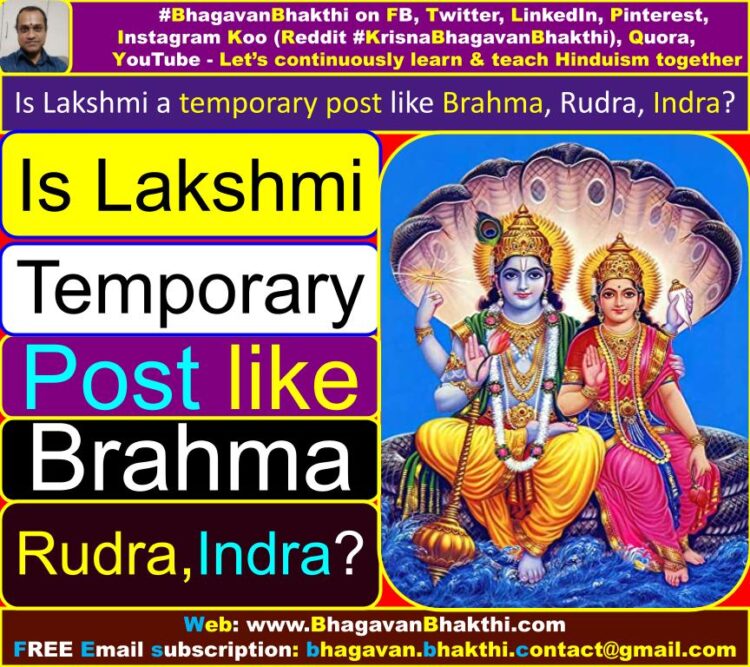
Let us have a small brief about both Bhagavan Lord Sri Vishnu and Bhagavati (Goddess) Sri Lakshmi Devi.
Bhagavati (Goddess) Sri Lakshmi Devi is the divine consort of Lord Sri Vishnu.
Goddess Sri (Maha) Lakshmi Devi in Sanskrit is written as लक्ष्मी / Lakṣmī.
Lakshmi means ‘she is someone who leads to one’s goal‘ (Laksha + me = goal + I am).
Many of us might know that Goddess Sri Lakshmi Devi is the Goddess of ‘aishwarya’, that is –
divine wealth, divine fortune, divine love, divine beauty, divine joy, divine prosperity etc. and also Goddess Sri Maha Lakshmi Devi is also associated with Maya (Illusion).
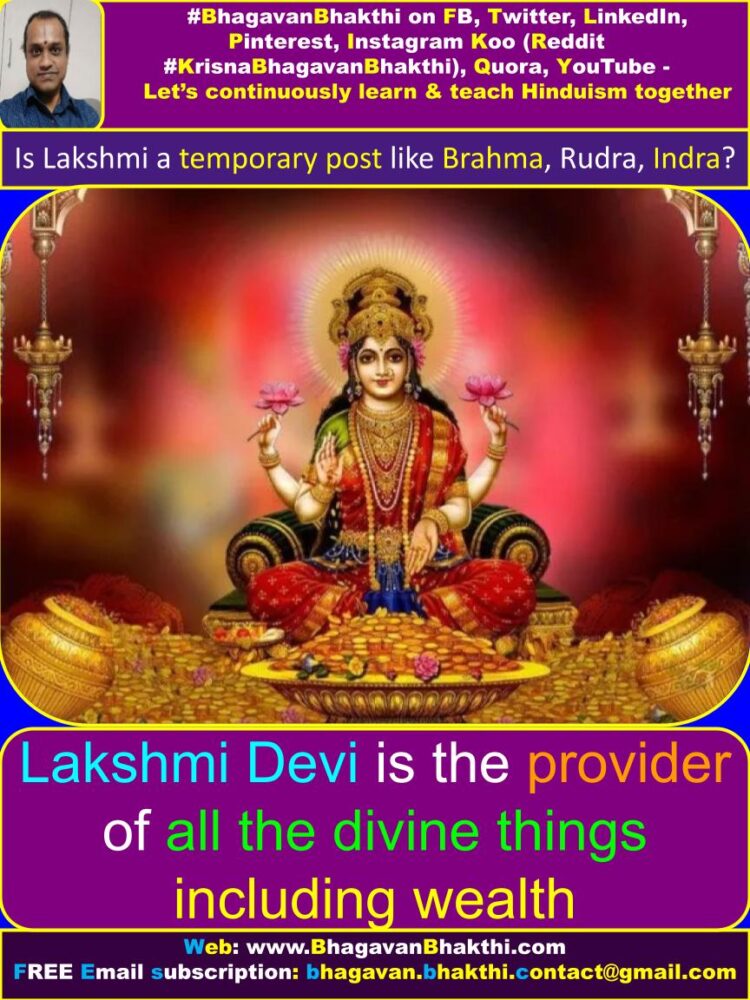
Among the ‘Tri Devis‘, Goddess Sri Lakshmi Devi is first in hierarchy (She is just after Lord Sri Vishnu).
The other two Devis are Goddess Sri Sarasvati Devi (Lord Sri Brahma Deva consort) and Goddess Sri Parvati Devi (Lord Shiva consort).
Whenever Lord Sri Vishnu takes avatar on earth, Goddess Sri Lakshmi Devi too takes avatar to do seva (serve) of Lord Sri Vishnu.
For example with Lord Sri Rama as Goddess Sri Lakshmi Devi takes the avatar of Goddess Sri Sita Devi,
similarly with Lord Sri Krishna as Goddess Sri Rukmini Devi & Goddess Sri Satyabhama Devi etc.
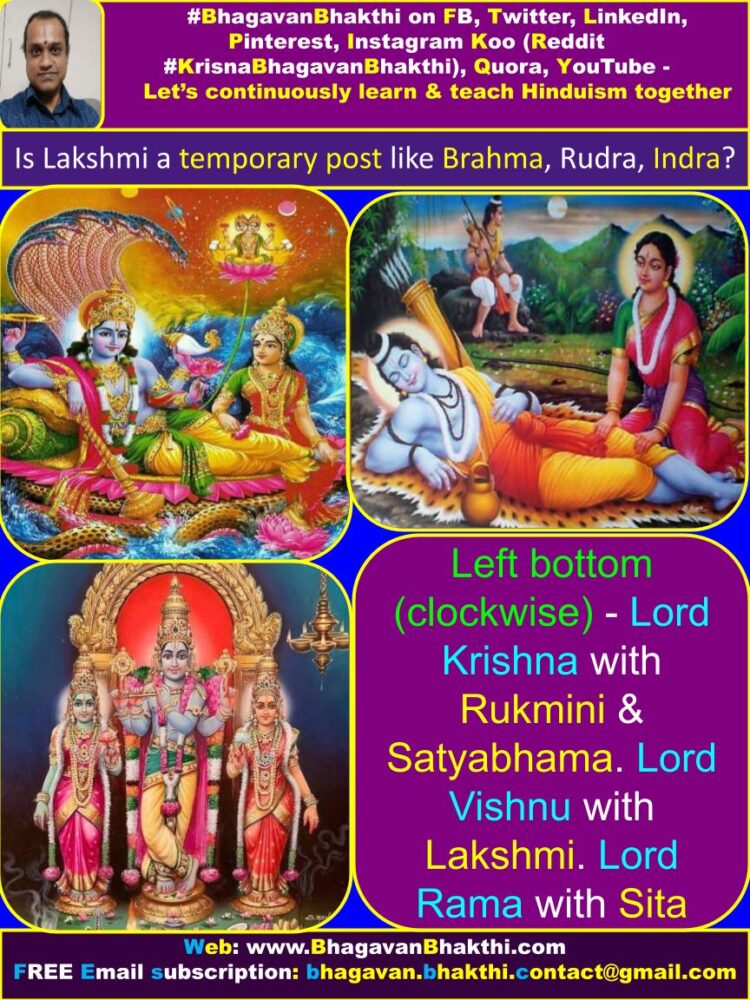
Like Lord Sri Brahma Deva’s padavi / position, Lord Sri Rudra Deva’s padavi / postion and Lord Sri Indra Deva’s padavi / position, Goddess Sri Lakshmi Devi is not having a padavi / position.
From unknown grand infinite time frame and until grand infinite time frame, Lord Sri Hari’s (Lord Sri Vishnu) consort will be only one, that is, Goddess Sri Maha Lakshmi Devi herself.
Padavi / position is given to jeevatmas (beings) only.
Goddess Sri Lakshmi Devi is not considered in the midst of jeevatmas (being).
Goddess Sri Lakshmi Devi is the chetana / power that belongs in ‘Ishakoti‘.
Goddess Sri Lakshmi Devi performs the service of the Supreme Bhagavan Lord Sri Vishnu through infinite posterities like Sri, Bhu and Durga.
All these three (Sri, Bhu and Durya) are the roopas / forms of Goddess Sri Lakshmi Devi herself.
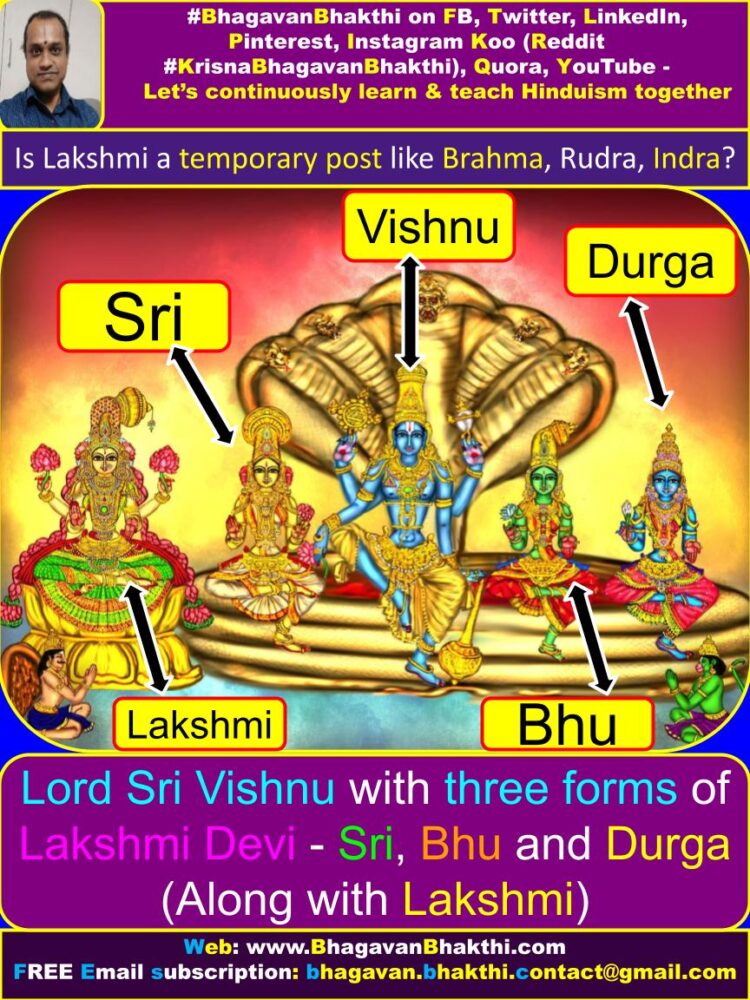
‘Sri‘ means Sridevi, ‘Bhu‘ means someone who is also called as ‘Dharaa Devi’ (Read as Dharaa / धरा and not as Dhaar or Dhaaraa / धार or धारा) and ‘Durga‘ is also another form of Goddess Sri Maha Lakshmi Devi.
Sattva guna abhimani LaxmI roopa is called ‘Sri’. LaxmI being all auspicious – is called as Sri.
During pralaya (great tribulation), pralayodaya Goddess Sri Lakshmi Devi exists as ‘Sri’. Sri exists as water.
RajO guna abhimani LaxmI roopa is called ‘Bhu’. During pralaya (great tribulation) Bhu Devi exists as vaTa patra (Banyan leaf) and serves Paramatma Lord Sri Narayana (Vishnu).
TamO guna Abhimani Laxmi roopa is called ‘Durga’ and she exists as darkness during pralaya (great tribulation).
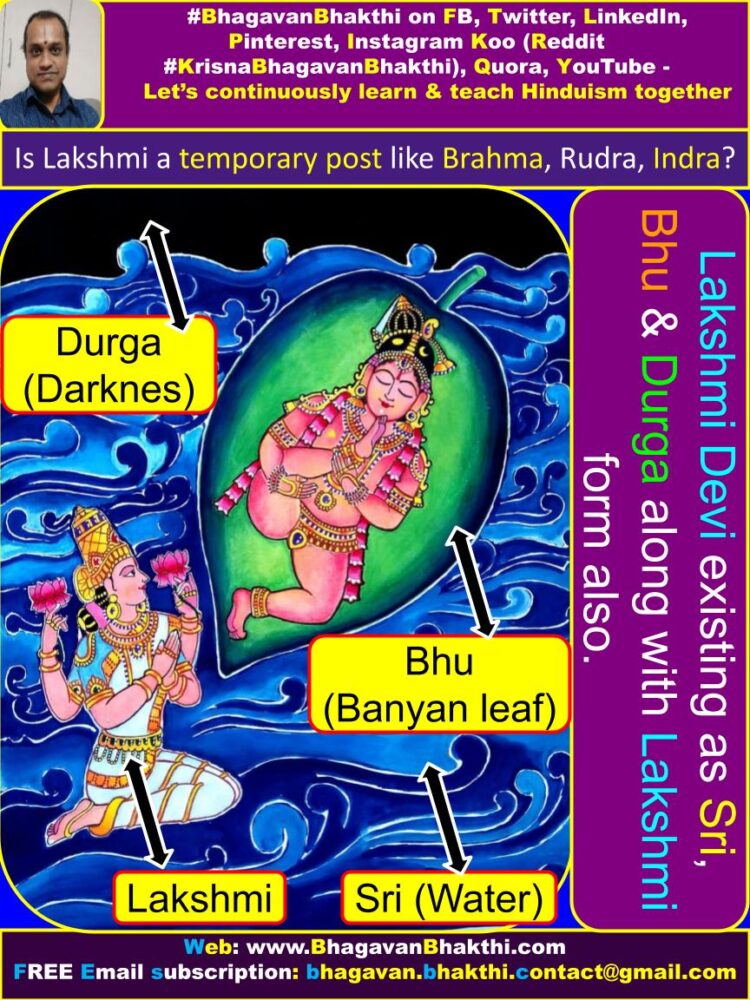
(This Bhu Devi is different and the mother earth Bhu Devi is different. This Bhu Devi is Goddess Sri Lakshmi Devi.)
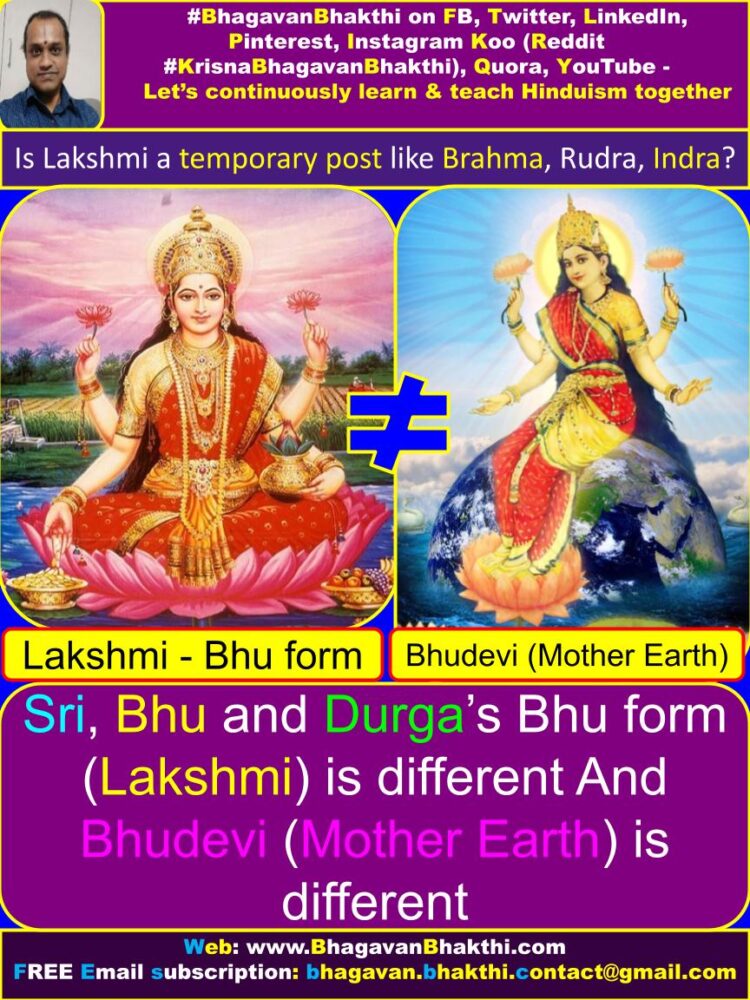
Since Goddess Sri Lakshmi Devi is ‘satva-rajO-tamO‘ guna abhimani (controlling Goddesss), she is referred as ‘triguna abhimani‘.
Lord Sri Hari (Vishnu) is the ‘niyamaka‘ (controller) of other infinite roopas (forms) of Goddess Sri Lakshmi Devi too,
apart from being niyamaka (controller) for the three roopas / forms of ‘Sri-Bhu-Durga‘.
Lord Sri Narayana (Vishnu) plays about in her manas (Divine mind) and pleases her all the time and he is doing this since ‘adi kalam‘ (Grand unknown age).
Lord Sri Hari (Vishnu) is therefore described as ‘Sridhara Durga Manorama‘.
Here ‘Sridhara Durga Manorama‘ means: Lord Sri Hari (Vishnu) is the holder (dhara) of Goddess ‘Sri’ (Goddess Sri Lakshmi Devi) in his ‘vaksha-shtala’ (chest) –
since grand unknown age in the three different forms, that is, first is ‘Sri‘, second is ‘Dhara‘ and third is ‘Durga‘.
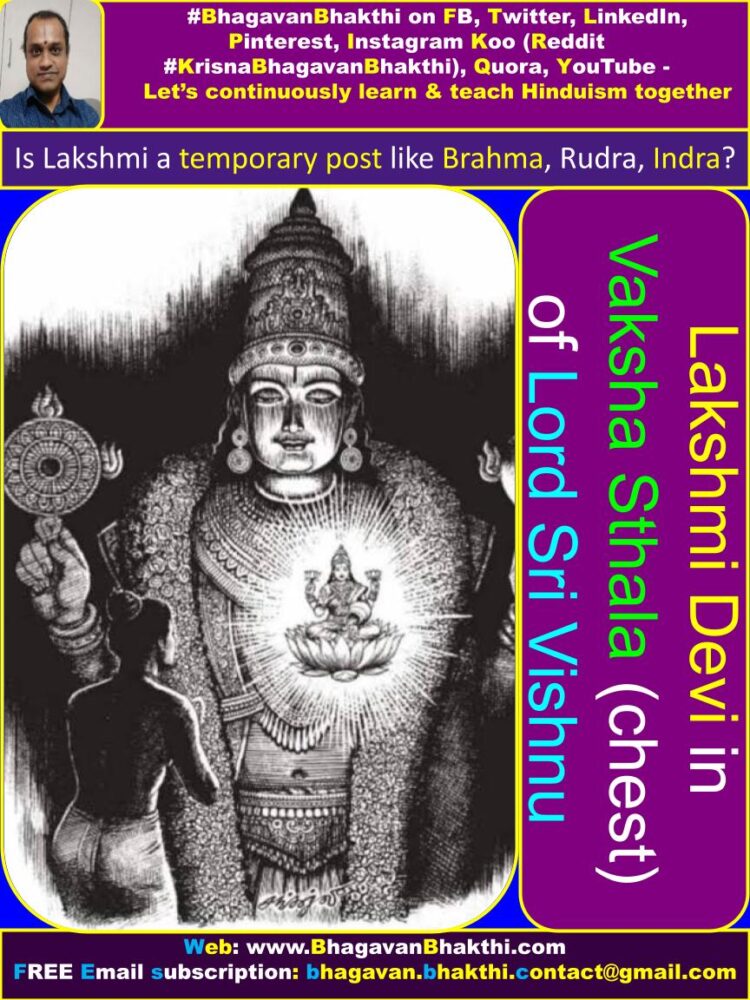
And Lord Sri Hari (Vishnu) divinely pleases (Manorama) Goddess Sri Maha Lakshmi Devi in her all the above said three forms.
This is happening since the ‘adi kalam‘ (Grand unknown age) and will continue until the ‘ananta kalam‘ (Grand infinite period).
Goddess Sri Lakshmi Devi is the only one who is the main consort of the Supreme Bhagavan (Lord Sri Vishnu), that is, Lord Sri Hari (Lord Sri Narayana).
In addition to Goddess Sri Maha Lakshmi Devi, the Paramatma Lord Sri Vishnu has several consorts.
Like, during the Lord Sri Varaha Avatar, Lord Sri Varaha swamy (Lord Sri Vishnu) marries Goddess Sri Bhoodevi (Mother Earth).
The Bhoomi / earth where we live is having an ‘abhimani Devata’ (Controlling Demigod) called Goddess Sri Bhoodevi (Mother Earth).
This Goddess Sri Bhoodevi (Mother Earth) is one of the consorts of Lord Sri Hari (Vishnu) (Varaha).
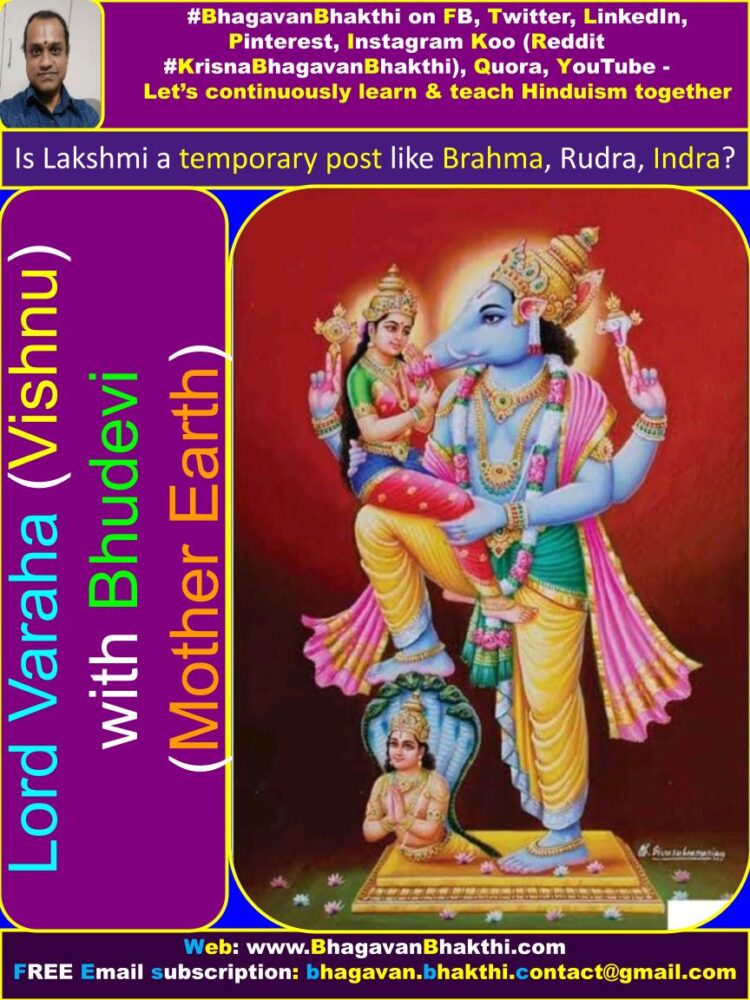
Goddess Sri Lakshmi also having the form of Goddess Sri Bhoodevi.
Goddess Sri Bhoodevi’s (Mother Earth) name is derived from Goddess Sri Lakshmi Devi,
as Goddess Sri Bhoodevi (Mother Earth) is having the sannidaana (divine presence) of svayam Goddess Sri Lakshmi Devi and also Bhoodevi is one of the roopa (form) of Goddess Sri Lakshmi Devi.
(But Goddess Sri Bhoodevi (Mother Earth) is not Goddess Sri Lakshmi Devi.)
Similarly, in the Lord Sri Krishna avatar, Shan Mahishis (six consorts), namely:
Jambavati Devi, Neela Devi, Bhadra Devi, Kalindi Devi, Mitravinda Devi and Lakshana Devi, becomes the consorts of the Supreme Lord Sri Krishna (Vishnu).
(All these Lord Sri Krishna consorts are not Goddess Sri Lakshmi Devi).
We should note that Goddess Sri Satyabhama Devi is also one of the avatars of Goddess Sri Lakshmi Devi, just like the Goddess Sri Rukmini Devi.
Along with Goddess Sri Rukmini Devi and Goddess Sri Satyabhama Devi all these eight consorts (including above said 6 wives) are called as ‘Ashta Mahishis‘ (Eight consorts).
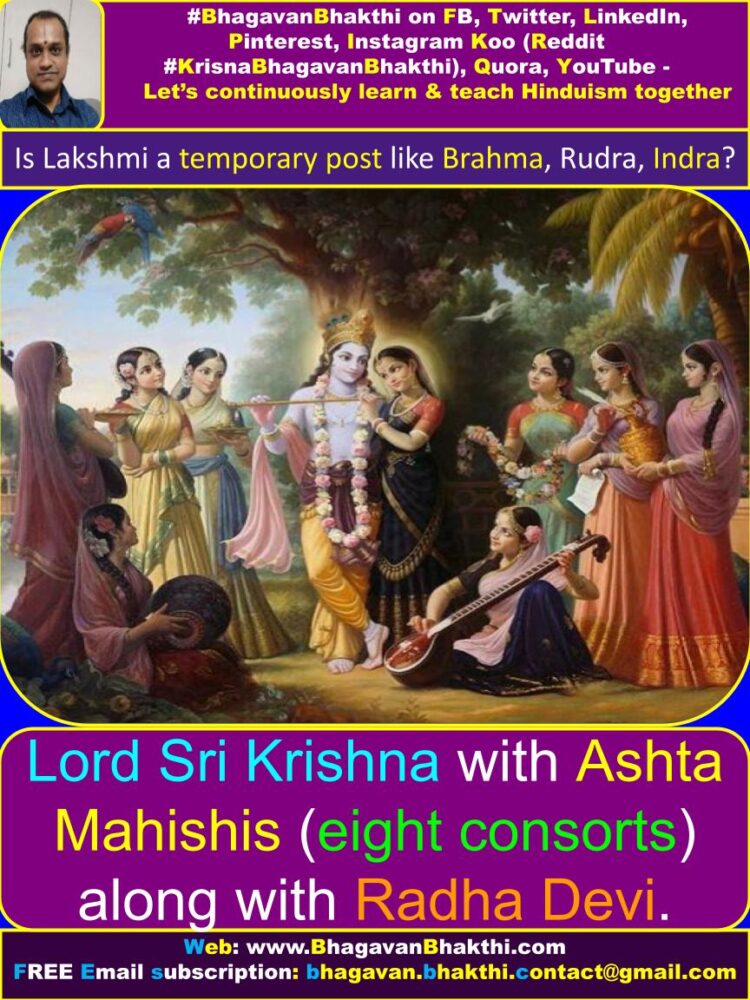
This means, both Goddess Sri Rukmini Devi and Goddess Sri Satyabhama Devi are one and the same, but having two different human forms.
This is done so as to teach the common people the lessons on how to be a good husband wife.
The Bhoodevi (Mother Earth), and Shanmahishis, i.e., here Shanmahishis means – Shan means six and mahishis means consorts, that is –
Jambavati, Neela, Bhadra, Kalindi, Mitravinda and Lakshana are the consorts of the Supreme Lord Sri Krishna (Vishnu).
All these consorts change in every Kalpa. That is, during the pralaya (great tribulation) all will get the supreme mukti / moksha (liberation).
Then, to that padavi / position, other Devis of the same group will become the consorts of the Lord Sri Hari (Vishnu) in the next Kalpa.
But only Goddess Sri Lakshmi is the one who never change and will always stay with Lord Sri Vishnu eternally (permanently).
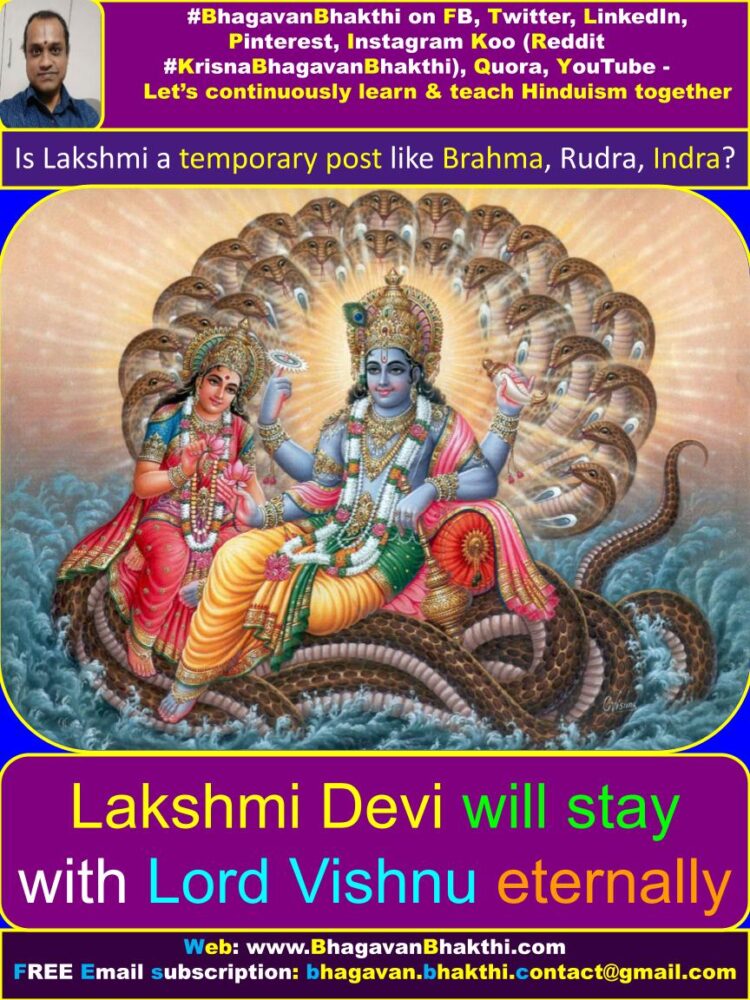
More information will be added to this on regular, please visit after some time to know more information.
To watch videos on #Hinduism #Sanskrit language, SUBSCRIBE to my YouTube channel from this below link:
#BhagavanBhakthi YouTube channel
To know more information about the “Different consorts and children of Sri Krishna“, you can visit my another post link:
Lord Sri Krishna wives and children names
To know more information about “What are Goddess Lakshmi names in different avatars along with Lord Hari’s names“, visit my another post link:
List of Goddess Sri Lakshmi Devi avatars (names)
Dear friends, if you need any clarifications about this post, kindly let me know, I will definitely try to answer all of them.
Also your one LIKE, one COMMENT, One Share, one SUBSCRIPTION is highly important.
This will help to know the quality of this content and also it will be helpful to know if any improvements is required for the content.
If you feel this content is useful to you and has helped you to improve your knowledge, kindly share this with your well-wishers.
Because “SHARING MEANS CARING”.
For receive FREE EMAIL SUBSCRIPTION about #BhagavanBhakthi, you can send an email to bhagavan.bhakthi.contact@gmail.com from your email ID.
NAMASTE!
Sri Gurubhyo namaha
Sri Krishnaaya namaha
Sri Krishnaarpanamastu
Share in Social Media